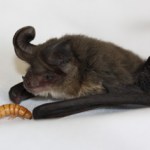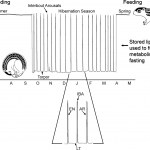torpor
Image of common hamster by katanski - Own work, CC BY 3.0, https://commons.wikimedia.org/w/index.php?curid=10550799
During hibernation common hamsters (Cricetus cricetus) alternate their time between bouts of torpor during which their metabolic rate drops and body temperature is low and arousal during which body temperature is normal. Hibernation allows animals to conserve energy although it is not without costs as it often results in memory deficits, cell damage and reduced immune function. Thus some studies have suggested that animals with sufficient food stores will not…
Arousal of a thirteen-lined ground squirrel from hibernation. By Uncredited; Walter L. Hahn [Public domain], via Wikimedia Commons
In a new study published in the American Journal of Physiology Regulatory, Integrative and Comparative Physiology, researchers at the University of Wisconsin, La Crosse were interested in understanding how thirteen-lined ground squirrels protect their brains during arousal from hibernation. This is a period of time in which the animals experience major changes in their body temperature and increased blood flow to the brain. The researchers knew…
Image of a Siberian hamster from Wikimedia Commons
Exposing Siberian hamsters (Phodopus sungorus) to shorter photoperiods (think winter) for about two months causes the animals to spontaneously undergo daily bouts of torpor during which time they decrease metabolic rate to conserve energy. New research published in the American Journal of Physiology - Regulatory, Integrative and Comparative Physiology was designed to examine whether decreases in growth hormone secretion was involved in stimulating these daily torpor episodes. By administering a chemical that…
Image of Gould's long-eared bat from http://www.wiresnr.org/Microbats.htmlImage by: Lib Ruytenberg
I came across a neat study published recently in the American Journal of Physiology - Regulatory, Integrative and Comparative Physiology which examined how bats arouse from hibernation, a period during which their body temperature and metabolism are low. To minimize the high energetic costs of warming up during arousal, bats use solar radiation or take advantage of fluctuations in the ambient temperatures (i.e. environmental).
Researchers studied hibernating long-eared bats (Nyctophilus…
Image from the American Physiological Society's website.http://www.the-aps.org/mm/Conferences/APS-Conferences/2014-Conferences/…
Wednesday was the last day of the meeting that culminated in a closing banquet with an awards session to honor students who had exceptional presentations. What an impressive group of young comparative physiologists! The plenary lecture was given by Dr. Steven Chown (Monash Univ, Australia). He spoke about climate change forecasts and continuing environmental changes and how important it is to understand how animals adapt to changing conditions in order to…
Female hummingbird, asleep.
Photo by Dylan Maldonado.
A flash of scarlet and emerald zooms past me as I poke my sleepy head out of the kitchen door, a vibrant splash of summer color against the sullen winter sky. Suddenly, an indignant Anna's Hummingbird, Calypte anna, confronts me, beak-to-nose, demanding his breakfast. Shivering, I retreat quickly into the kitchen to prepare warm sugar water for my feathery guest.
Hummingbirds are classified into the avian family, Trochilidae, which is from the Greek word, trochilos, or "small bird." In fact, the smallest avian species alive today is the…

